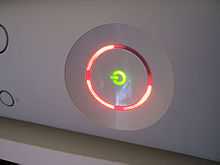Power symbol

A power symbol is a symbol indicating that a control activates or deactivates a particular device. It incorporates line and circle figures, with the arrangement informed by the function of the control. The universal power symbols are described in the International Electrotechnical Commission 60417 standard, Graphical symbols for use on equipment, appearing in the 1973 edition of the document (as IEC 417) and informally used earlier.[1]
The power symbol was the result of the logical evolution of a simple user interface, with most early power controls being simple switches that were toggled between two states demarcated by the words On and Off. As technology became more ubiquitous though, the English words were replaced by the universal numeral symbols 1 and 0 to bypass any possible language barriers. These symbols were later super-imposed on one another when the standard switch for a power control was replaced by a single button which toggled between power states, giving us the universally recognized power symbol we know today. Because of this widespread use, an effort is currently in place to add the set of characters to Unicode.
Definitions
| | IEC 5007, the power on symbol (line), appearing on a button or one end of a toggle switch indicates that the control places the equipment into a fully powered state. It comes from the binary system ("1" means "on"). |
| | IEC 5008, the power off symbol (circle) on a button or toggle, indicates that using the control will disconnect power to the device. It comes from the binary system ("0" means "off"). |
| | IEC 5009, the standby symbol (line partially within a broken circle), indicates a sleep mode or low power state. The switch does not fully disconnect the device from its power supply. This may appear on a toggle switch opposite a power on symbol, alone on a pushbutton that places the device into a standby state, or alone on a button that switches between on and standby. Alternatively, under IEEE 1621, this symbol simply means "power".[2] |
| | IEC 5010, the power on-off symbol (line within a circle), is used on buttons that switch a device between on and fully off states. |
| | A waning moon, indicating sleep mode, is added by IEEE 1621 as a replacement for the standby symbol. |
Standby symbol ambiguity
Because the exact meaning of the standby symbol on a given device may be unclear until the control is tried, it has been proposed that a separate sleep symbol, a waning moon, instead be used to indicate a low power state. Proponents include the California Energy Commission and the Institute of Electrical and Electronics Engineers. Under this proposal, the older standby symbol would be redefined as a generic "power" indication, in cases where the difference between it and the other power symbols would not present a safety concern. This alternative symbolism was published as IEEE standard 1621 on December 8, 2004.[1][3][4][5]
In popular culture
The standby symbol, frequently seen on personal computers, is a popular icon among technology enthusiasts. It is often found emblazoned on fashion items including T-shirts and cuff-links.[6] It has also been used in corporate logos, such as for Gateway, Inc. (circa 2002), Staples, Inc. easytech, Exelon, Toggl and others,[1] and even as personal tattoos. In March 2010, the New York City health department announced they would be using it on condom wrappers.[7] The 2012 TV series Revolution, set in a dystopian future in which "the power went out", as the opening narration puts it, stylized the last letter 'o' of its title as the standby symbol.
See also
References
|
- ↑ 1.0 1.1 1.2 Lawrence Berkeley National Laboratory (December 2002). "The Power Control User Interface Standard (consultant report)" (PDF). California Energy Commission. Retrieved 2007-04-26.
- ↑ Nordman, Bruce (2005-05-02). "Power Control Made Easy". EE Product News. Retrieved 2007-04-26.
- ↑ Lawrence Berkeley National Laboratory (December 2002). "Draft Standard for User Interface Elements in Power Control of Electronic Devices Employed in Office/Consumer Environments (consultant report)" (PDF). California Energy Commission. Retrieved 2007-04-26.
- ↑ "Save Energy at Your PC; Energy Scientists Propose Color-Coding Standard for PC Sleep Mode". American Institute of Physics. 2005-06-01. Retrieved 2007-04-26.
- ↑ "Power Management Controls - User Interface Standard - IEEE 1621". IEEE. Retrieved 2007-04-26.
- ↑ See for example "Adafruit's iCufflinks pulsate with the power of your Mac love".
- ↑ Smith, Robert (2010-03-09). "Official Condom Design: New York's New Sex Symbol". National Public Radio. Retrieved 2011-02-09.
- IEC/ISO Database on Graphical Symbols for Use on Equipment
- ISO/IEC/JTC1 Graphical Symbols for Office Equipment, Environmental Energy Technologies Division, Lawrence Berkeley National Laboratory